|
July 25, 2005
Mony Dojeiji and her 5000 km Walk for Peace
from Rome to Jerusalem
One of the absolute pleasures of working on this website is that
I am able to connect with some phenomenal people. Individuals who
have done unusual things, and in many cases made a contribution
to important causes.
The connection to Mony came to me through my friend Sue
Kenney who put me in touch with another kindred spirit. Just
today I added another woman to my list of spiritually evolved human
beings, and that was Danielle
Lafond, who is setting up a non-profit community development
program in a little town in Peru. So the circle of fascinating individuals
keeps on growing.
Here is part 1 of Mony's story (she is still working on the rest
of the interview questions), who went from being a Microsoft sales
executive to completing a pilgrimage on the world-famous Camino
de Santiago, which made her decide to complete a 5000 km long Walk
for Peace for 13 months through 13 countries.
1. Please tell us a bit about your background. Where are
you from, where did you grow up?
I’m originally Lebanese. My parents emigrated to Canada
in the early 1960s. I’m the oldest of four children. I, my
brother and two sisters were all born and raised in Canada. Until
the age of ten, we alternated between living between Canada and
Lebanon. I was educated in Lebanon, where I learned to speak English
and French. When the Lebanese civil war broke out in 1975, the whole
family moved back to live in Ottawa for good.
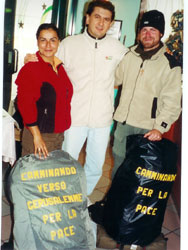
Mony in Italy
2. Please give us a bit of an idea of your educational
and work background. What made you decide to leave your corporate
career?
I have a Bachelor of Science (Biology concentration) from the University
of Ottawa and an MBA from Queen’s University. I was originally
trying to get into medical school, but after several failed attempts,
I decided I was more interested in the business world and pursued
the MBA. I started my career working for Arthur Andersen in their
technology consulting group, and then three years later, moved to
Microsoft where I stayed for seven years working in various roles
in sales and marketing, mainly as product/marketing manager and
account manager. I also worked for one year at the corporate head
office in the US as part of a team focused on customer satisfaction.
In the last two years of work, I had been going through a lot of
personal changes and was feeling the need to make a change in my
life as a whole. It started with my divorce in 1998 which started
me down the path of questioning how I got to that point, why this
had happened to me, what my life was about. I went to a therapist
but found it only answered part of my questions. It was a good start
but I was searching for deeper meaning. My search led me to the
self-help and spirituality sections of the bookstore. One book especially
completed changed my life and perspective on how I saw the world
and my place in it. It was Conversations with God Book 1 by Neale
Donald Walsch. The book spoke simply and defined God as an energy
of unconditional love that was around us and within us, waiting
to be manifested through our thoughts and actions. That God spoke
to us constantly through our feelings and intuition, and through
signs, coincidences, synchronicities using all instruments so that
we would receive the message. It challenged me to accept responsibility
for my life, and not simply blame my circumstances on other people;
that I was the creator of my life and not its victim. It spoke of
sacred contracts before birth and the people and experiences in
my life as opportunities for my spiritual growth. That to change
my world, I had to change myself first.
I didn’t understand it all at first, but it rang intuitively
true. I started trying to live what I read. I started being aware
of signs, of people walking into my life coincidentally just when
I needed them. I would read or hear something that was an answer
to a question I had. I started meditating in an attempt to calm
my mind and to allow my deeper wisdom to surface. I started practicing
yoga, originally to stretch my body, but found the incredible openness
and flexibility that it gave me, not just physically but emotionally
as well. I started to look at all the difficult relationships and
situations in my life more honestly, and tried to heal them. I became
(and still am) vegetarian and found that it helped me feel physically
lighter and more energetic. I took the lessons that I read to heart
and tried to change my life.
I tried to bring my newfound peace and positive thinking into my
work situations, but found the struggle too difficult. I was increasingly
unhappy and dissatisfied with what I was doing, but was afraid to
leave the comfort and security of what I knew. After an especially
stressful period at work, and with all the personal changes going
on, I finally decided it was time to leave. I resigned in August
of 2000.
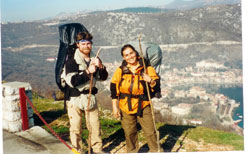
Mony in Croatia
3. After you left your corporate career, you went on a
pilgrimage on the Camino de Santiago. Why did you do that and what
was your experience?
After I quit, I decided I needed some time off. I booked a one-year
return ticket and started my travels in January of 2001, starting
in Egypt and moving around Europe.
I had read about the Camino to Santiago before my travels and felt
drawn to it. In June of 2001, I arrived in St. Jean Pied du Port
in the south of France and took my first steps as a pilgrim. I was
walking with the intention of trying to find clarity and purpose
in my life. I wanted to live a life with meaning, doing something
positive that contributed to the good things that I knew were going
on in the world but were unknown and uncelebrated. I had always
been attracted to the peace process in the Middle East. As a child,
I would sit and listen as all the men sat and talked about the latest
news from their homeland. I loved the political discussions and
was always fascinated by what I heard. So I knew I was interested
in doing something for peace, but I didn’t know the details
of what that meant. In walking, I was hoping to receive some new
details.
It’s hard to summarize in a few sentences my experiences
along the Camino. I can tell you that I learned some important lessons.
In the beginning, I tried to dominate the Camino, seeing it as one
more thing to conquer. But the Camino quickly fixed that, giving
me unbelievable blisters and pain that stopped me in my tracks as
soon as I started. I had to leave my ego behind, and learn to open
my heart. That was my first lesson and the foundation for doing
a pilgrimage. As I walked, I saw that the Camino was alive and had
its own rhythm. I needed to learn how to flow with it, not master
it. Only then could I hear the wisdom. I learned to stay in the
present and only focus on what was in front of me. I learned to
walk slowly and in gratitude. I felt grateful for sunshine and for
rain; clear blue skies and clouds; flat open trails and hilly mountains;
solitude and companionship; strength and flexibility. I found strength
I never knew I had, physical and emotional. I learned that I needed
very little – a roof over my head, a warm sleeping bag, one
change of clothing, and basic toiletries. I could wear the same
clothes and eat the same food every day without question. I felt
free in the simplicity.
I saw my fears presented before me through the many encounters
I had. The majority can be summarized as one thing - the fear of
standing out and doing something different, always worrying about
what other people thought. I needed to release that fear before
I could really receive what I needed. The Camino gave me the gift
of seeing these fears and the opportunity to heal them. The biggest
lesson I learned was that when I change, others around me also change.
Although I had read that, it was not until I lived it that I saw
its truth.
4. While on the Camino, you came up with the idea of going
on a long walk for peace. I also hear that September 11 had something
to do with it. How did that idea come about?
Really, it was inspiration. I was taking a break after a day’s
walk along the Camino when I heard a group of pilgrims nearby talking.
They were sharing their stories of the day when one of them said,
“I heard that this Camino is called the Way of the Sword,
of Strength. It’s where you battle your demons and find your
strength. The way to Rome is called the Way of the Heart, the way
of Love. And the way to Jerusalem is called the way of the Soul.”
It was those last words that struck a chord deep inside me. I didn’t
know what it all meant exactly, but I knew in that moment that I
had to walk to Jerusalem, that it was the way of My Soul. It would
take me until the end of my Camino before it would become clearer
in my mind that I would walk to Jerusalem for peace, and that that
would be my contribution to the peace efforts there. In the following
two months, I had moments of absolute certainty where I knew that
this was the way, mingled with bouts of anxiety and doubt, thinking
this was the stupidest idea I ever had. My mind kept playing out
its deepest fears over a woman walking alone on such a long journey
through unfamiliar countries, cultures and languages. In my heart
I was already walking and felt excited by the whole idea. But I
deferred to my mind, feeling more confident in its wisdom than in
my heart’s.
And then September 11 hit. I was horrified at what I saw. The subsequent
American threats of retaliation and revenge only confirmed my belief
that what the world needed now more than ever were people doing
their part for peace, holding on to the hope that peace is still
possible, even in the midst of the carnage and violence. I believed
that people can do their part, no matter how small or insignificant
it may seem, to change the world. I learned first-hand on the Camino
that when I changed, the world around me changed. I now had the
chance to live it for real.
So, in a strange way, these attacks gave me the push that I needed.
Not because I had overcome any of my fears. Or because I had any
answers. But because walking was the only constructive thing I knew
how to do. Walking to Jerusalem would be my contribution to peace.
I felt empowered by the idea because it placed the control and responsibility
for creating peace in my world and in my life back in my hands.
On the Camino to Santiago, walking was my meditation, an inner focus
reflected in an outer journey. With each step, I felt closer to
myself, to the best part of me, the part that was open, trusting
in the goodness of people, seeing their light rather than their
darkness. That was the part of me that wanted to emerge and share
itself with the world. That was all I could offer. Walking to Jerusalem
would become my meditation, my prayer, for peace. With each step,
I would attempt to find the peace within me and share that with
the people I came in contact with.
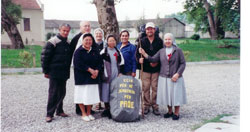
Mony in Albania
5. Please tell us about the time leading up to your Walk
for Peace. How did you decide on your route, what preparations did
you undertake?
I started researching the Internet for ancient routes to Jerusalem,
and found the web site of a 52-year old Dutch woman who had walked
from The Hague to Jerusalem the year before. Her name was Johanna
van Fessem. I sent her an email introducing myself and telling her
about my plan. She responded right away and we struck up an immediate
rapport by email. She told me she drew a straight line between her
home in The Hague and Jerusalem, and then walked that route. She
also told me about Jeanette Albers, another 50-year old Dutch woman
who had walked from Amsterdam to Jerusalem the same year, but taking
a different route. Jeanette had walked from Amsterdam to Bari (Italy),
took a boat to Haifa (Israel), and then walked to Jerusalem. I already
knew about Jeanette and had spoken to her briefly by telephone through
some friends who knew her from the Camino to Santiago.
They both invited me to meet with them in Holland before starting
my journey. I felt that would be the best preparation – to
learn from the experiences of fellow pilgrims. It was now early
October. I was still on the continent, so I packed up my backpack
and booked my flight to Amsterdam. Johanna and Jeanette were both
incredibly supportive of my walk and encouraged me to simply walk
without worrying about the details. To just be open and let the
Universe/God/the angels be my guide. That I was protected and would
be led to where I needed to be. Their biggest advice to me was to
simply trust the process that had led me this far. I felt very fortunate
to have met them. In them, I had found two kindred spirits, two
angels really, who were sent into my path to reassure me, to show
me that I wasn’t alone, neither in my thinking nor in my intentions.
I also used my time in Amsterdam to buy equipment I thought I would
need for walking in the winter such as a tent, warm sleeping bag,
fleece sweater, wool socks, compass, and basic camping supplies
(lightweight pot, plate, utensils, rope). Both Johanna and Jeanette
had told me to pack light, so I was trying to buy as little as possible.
They told me to buy my maps along the way and not be burdened with
their weight. I also learned about a women's outdoor survival weekend
which was taking place while I was in Amsterdam. This felt like
an incredible gift, as I had very little confidence in camping alone.
In case I needed to do it, I wanted to feel prepared to camp out
by myself. A week later, I was learning how to use my compass and
read the stars, how to pitch my tent and start a fire in total darkness.
I decided that the Vatican in Rome would be my starting point.
It symbolized the Heart, the centre of Love, and was a clear landmark.
Although I didn’t walk the Way of the Heart to get there,
I felt it was quite symbolic to be walking from the Heart and making
my way to the Soul. For me, the Way of the Soul was about remembering
who I really am, and living it. That my life isn’t simply
about taking but giving. That we are all connected and what I do
for others, I do for myself, and vice versa. By expressing that
and sharing that with the world, my Soul is alive and living its
True Purpose.
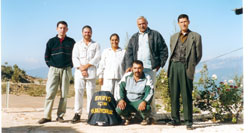
Mony in Turkey
6. Your walk started in Rome and you mentioned that Italy
was your testing ground. Please tell us about your walking experience
in Italy.
The first ten days of my pilgrimage I walked alone. I started walking
on November 21, 2001 heading north in the direction of Assisi. My
map only brought me to that point. I had the intention of walking
towards the Adriatic coast, then northward to Venice and then down
the other side of the Adriatic to Greece, then east towards Turkey,
and the Middle East. I had no concrete plans, just a general idea.
I wanted to camp out my first night and put into practice my intentions
to let go and trust. If I could camp out as a woman alone at night
in a foreign country where I couldn’t speak the language,
with all the unknowns of this journey still ahead of me, then I
would be facing my fears directly. My deepest fear was that of being
attacked, raped and possibly killed. No one knew exactly where I
was. I had no firm plans. No one knew my exact route – I didn’t
really have one. No one was waiting for me at the end of the day
or calling me to make sure I arrived safely. If I disappeared, no
one would find me. That was the deepest fear I wanted to confront.
I did not want it to fester in hidden places within me, manifesting
itself whenever and however it wanted. I camped out my first night
and nothing happened. I slept blissfully until the following morning.
My first few days of walking were difficult. This wasn't like walking
the Camino to Santiago with beautifully marked trails and fields.
I was walking on the open road with little or no sidewalk. I couldn't
find a natural rhythm and was spending a lot of energy watching
the roads and the cars. I was walking facing the traffic and felt
the wind and exhaust in my face all day. People were honking at
me and gesturing at me from their cars. Things got better when I
found the country roads where there were fewer cars and people.
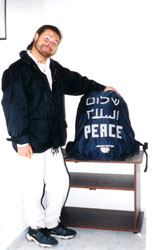
Alberto in Israel
My greatest frustration and obstacle was communication. To my surprise,
most people I met only spoke Italian. I spoke English, French, Arabic
and a few words of Spanish. I communicated using a mix of English
and Spanish, and a lot of sign language. I really couldn’t
explain why I was walking and when I did, people just thought I
was pretty strange. With my heavy backpack and walking boots, many
people thought I was an ‘alpinista’- a hiker or mountaineer.
I couldn’t correct them or explain anything to them. I had
to be content with the silence.
But I was also met with a lot of hospitality and people who were
genuinely interested in what I was doing and helped me along my
way, either by helping me find accommodations or offering to buy
me lunch or coffee, or simply to shake my hand and pat my shoulder,
which meant more to me than they could ever imagine. It was those
moments that kept me going and gave me confidence and faith that
I was doing the right thing.
I had met a fellow pilgrim on the Camino to Santiago and when he
heard about my plan to walk, felt drawn to walk it with me. His
name was Alberto Agraso, from Cadiz Spain. I started from Rome alone
and he joined me ten days later. On December 4, 2001 we started
walking together from Rieti.
7. What about the practical considerations of this 5000
km walk? Where did you sleep? What did you eat? What was your daily
routine like? How physically strenuous was it?
When I was walking alone, I stayed in hostels and when I couldn’t
find them, I went to a monastery or church and asked for help. When
Alberto started walking with me, he wanted to walk like pilgrims
of old and preferred to go directly to monasteries and churches
for help. Which is what we did in the end. Usually we started walking
at around 8:00 in the morning, taking small breaks when we felt
tired, stopping at cafes or bars in small towns when we found them.
We carried some food and water with us in case we couldn’t
find an open café. We usually had cookies and often some
bread. We normally walked between 20 and 25km a day. When we stopped
for the day, we would find the church or monastery in town and ask
for the priest or person in charge. We would explain that we were
walking to Jerusalem for peace and only needed a roof over our heads
for the evening. We didn’t need beds or showers. We could
sleep on the floor. We explained we had sleeping bags, food and
money, and would be gone in the morning. In the majority of cases,
we were warmly welcomed.
Most times we slept on the floor or on a table in a church hall
in our sleeping bags. Typically, there was no heat or hot water.
But many times, we found beds and hot water and heating. When there
was hot water and heaters we could shower and wash our clothes.
Without hot water, we used baby wipes to wash ourselves. Often we
were invited to eat by the priest which we always appreciated. Other
times, we ate what we found in the supermarket – cheese, bread,
mayonnaise, butter, pate in a tube, cookies. It all depended on
the day and the size of the market we were in.
Other times still, we were invited into peoples’ homes and
treated to a warm home-cooked meal. Those were the special occasions
that meant a lot to us. In the evenings, we would write in our diaries
and look at our map to decide the route for the next day. We would
then roll out our foam mats and sleeping bags and sleep by 10:00.
We woke up at around 7:00 the next morning, packed up our things,
and had coffee with the priest or at the nearest café.
In the beginning, the walk was challenging because our packs were
heavy, mine weighing about 17kg and Alberto’s over 20kg. We
were carrying winter gear and tents. In the early weeks of our walk,
we also were walking in the foothills of the Appenine Mountains
on fairly challenging terrain. We both got walking sticks to help
us support the weight of our backpacks, especially as we were going
downhill. The only pain I felt was in my knees and ankles when going
downhill. But our bodies became accustomed very quickly, remembering
a similar pilgrimage only a few months earlier.
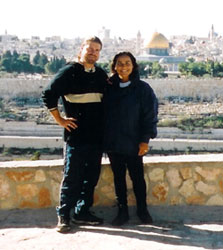
Mony and Alberto in Jerusalem
8. You also had a walking partner for the majority of this
walk. Please tell us how that came about and how this relationship
has developed.
I met Alberto in Finisterre, 100km west of Santiago de Compostela.
He was in the company of a fellow pilgrim from Germany named Linda
that I had walked almost the entire way with. I shared with them
my idea about walking to Jerusalem. They were supportive but didn’t
feel any strong attraction to do it. He spoke little English but
I found out through Linda that he was from Cadiz in the south of
Spain. He had left his job as an insurance adjustor at a large Spanish
insurance company (MAPFRE) because he was feeling dissatisfied with
his work and was trying to live a life with purpose. He loved to
paint and sculpt, and was making his living from selling his work.
It was a simple life but he was happy and always had enough. He
was a deeply spiritual man and had gone through a spiritual transformation
at the sudden death of his best friend in a construction accident.
It made him reexamine his life and determine that he would live
a life that was meaningful and contributing to something positive
in the world.
We parted ways that same day. A few months later, in late October,
on my way from Amsterdam to Rome to begin my walk, I stopped in
Germany to see Linda and was surprised to see Alberto there. He
had moved to Germany about a month earlier and was in a relationship
with her. I was sharing with them my final plans for walking to
Jerusalem, but this time something changed. Alberto told me he started
receiving strong, indisputable signs that he needed to walk with
me. He didn’t understand why, but the signs were persistent,
appearing everywhere and in many forms. They were clear and he was
sure about his interpretation of them. It was a difficult time for
all of us. Linda had just started a new job and could not join us.
She didn’t feel any real attraction to what I was doing, even
though she supported it. In the end, Alberto made the difficult
decision to leave the relationship and to follow what he believed
to be his calling.
Our greatest challenge when we started walking was communication.
He spoke little English, only what he had studied in school, and
my Spanish was limited to the few words I had learned on the Camino.
We spoke slowly using simple words and sentences, and lots of sign
language, so we could understand each other. Eventually, we both
learned to speak Italian and our conversations were usually a mix
of English, Spanish, Italian and sign language. No one ever had
a clue what we were saying or where we were from.
We started out as walking partners, pilgrims believing in the same
cause, wanting to contribute to the fabric of peace in the world.
For me in the beginning, I was walking for peace in Jerusalem. For
him, it was peace in general, starting with inner peace and radiating
out, like a pebble in a pond. After walking almost six months together
and living through incredible experiences, many difficult and overwhelming,
others of pure magic, our relationship developed from acquaintance
to friendship and eventually to romance. He is now my husband and
we live together in his hometown of Cadiz with our nineteen month
old daughter Sylvana.
This is part one of Mony's interview. Please stay tuned for the
second part which will be completed over the next few weeks. Thank
you, Mony, for so intimately sharing the story of your transformation
with us. I look forward to hearing more about the phenomenal changes
in your life.
Related Artices:
Money Dojeiji and her 5000 km Walk for Peace - Part
II
Sue Kenney and her pilgrimage
on the Camino de Santiago
On a day that I played hooky from the office I realized that Sue
and I are kindred
spirits
Read Danielle's story
who together with her husband mortgaged her home to start a non-profit
community development project to help a Peruvian town in need
|